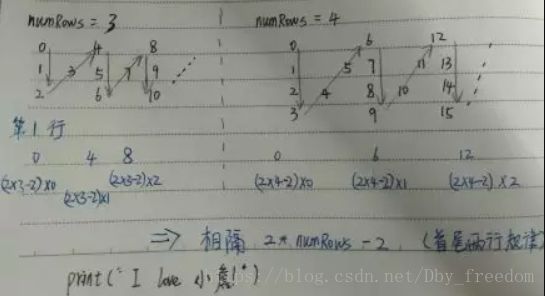LeetCode 6. ZigZag Conversion(Z字型变换)
原题:
The string “PAYPALISHIRING” is written in a zigzag pattern on a given number of rows like this: (you may want to display this pattern in a fixed font for better legibility)
题目大意:将字符串 “PAYPALISHIRING” 以Z字形排列成给定的行数,之后从左往右,逐行读取字符:”PAHNAPLSIIGYIR”实现一个将字符串进行指定行数变换的函数:
P A H N
A P L S I I G
Y I RAnd then read line by line: “PAHNAPLSIIGYIR”
Write the code that will take a string and make this conversion given a number of rows:
string convert(string s, int numRows);
Example 1:
Input: s = "PAYPALISHIRING", numRows = 3
Output: "PAHNAPLSIIGYIR"Example 2:
Input: s = "PAYPALISHIRING", numRows = 4
Output: "PINALSIGYAHRPI"
Explanation:
P I N
A L S I G
Y A H R
P IReference solution
题目分析:看到这种题目,必须先找规律,就像本科c语言学习过程一样。首先找到两列的规律,在纸上一顿乱画……然后发现:第一行比较具有代表性,其他行可以通过第一行加减得到,而第一行相邻两列之间相隔为2*numRows-2,下面就以numRows分别为3和4为例,画出来方便小伙伴理解(字丑人帅噢)
得到了这就可以往下继续思考了~我们可以依次打印出每一行,第一行简单,字符串的索引符合2*numRows-2的整数倍即可。之后只用依次加上行数或者减去行数即可,例如i表示第几行(为方便,从0开始,第0行、1行…i行…)。这里提供一种取模的方法(可以理解成余数)。这里得观察到首末两行比较简单,字符在字符串中对应索引除以2*numRows-2模为0或者numRows-1;中间若干行,要多出一种情况,取模为i(从上往下箭头方向)或者2*numRows-2-i(从下往上箭头方向)。
于是我们可以逐行输出,第一层循环为遍历所有行,第二层循环遍历所有符合对应行的字符。代码和注释如下:
class Solution:
def convert(self, s, numRows):
"""
:type s: str
:type numRows: int
:rtype: str
"""
n = numRows
#开始小詹是利用列表保存,然后得到结果
#再将其转换为字符串的,这里定义空的列表
res_list = []
l = len(s)
#考虑到极端情况,其实这里小詹还是没有考虑全
#除了一行,还应该考虑到单字符串或者空字符串
if n == 1:
return s
#遍历0到n-1行
for i in range(n):
#遍历所有字符,j表示索引
for j in range(l):
#这是就是小詹介绍的取模判断是否在第i行输出
if j%(2*n-2) == i or j%(2*n-2) == 2*n-2-i:
res_list.append(s[j])
#这里就是利用join将列表转换为字符串
res = "".join(res_list)
return res是不是觉得很简单?不,超时了你敢信,虽然执行出得到了正确结果,但是提交显示超时!分析下,做了哪些无用的计算呢?这里注意到for j in range(l):遍历了所有的索引,但是事实上是有规律可循的,并不需要暴力遍历所有。
Note: 列表转换字符串方式:利用join将列表转换为字符串res = “”.join(res_list)
代码
class Solution(object):
def convert(self, s, numRows):
"""
:type s: str
:type numRows: int
:rtype: str
"""
str_length = len(s)
node_length = 2*numRows - 2 # 两列之间的差
#其实并不需要第一种方法那样列表字符串来回折腾。。。
result = ""
#极端特殊情况,直接返回原字符串
if str_length == 0 or numRows == 0 or numRows == 1:
return s
# 从第一行遍历到最后一行
for i in range(numRows):
#大的改进在这里!!!不再逐一遍历,而相当于j += node_length
for j in range(i, str_length, node_length):
# 第一行和最后一行 还有普通行的整列数字
result += s[j]
#不是第一行和最后一行,且不说普通垂直的时,j-*i+node_length得到第i行斜着的那部分需输出的字符
if i != 0 and i != numRows-1 and j - 2*i + node_length < str_length:
result += s[j-2*i+node_length] # 单列行的数字
return result到这就得到了可以通过的正确解答了,写文章比做题还耗时……感兴趣的小伙伴可以提交try一下噢!
注:自身本道题问题出在了试图直接一下子找到对应结果的索引对应关系,大大增加了问题的难度,如参考答案一样,先走一遍行循环,只需找出每行索引关于行索引以及循环数的关系即可。
